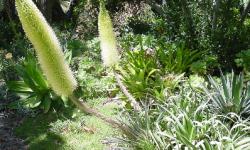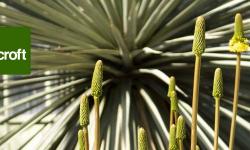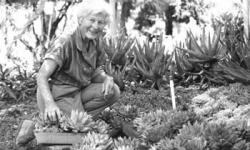The Ruth Bancroft Garden in Walnut Creek, California, United States, occupies land that was once part of a 400-acre fruit farm that produced walnuts and Bartlett pears in the Ygnacio Valley. The farm was started in the 1880s by Hubert Howe Bancroft, a famous historian and publisher who amassed a huge personal library of books related to the American West. Bancroft sold his important collection to the University of California, which became the nucleus of The Bancroft Library.
In the 1930s the farm was awarded first place in the state for pears 8 out of 9 years. At the height of production the farm had 200 seasonal employees. Pears were shipped to the East and as far away as England.The farm was passed down to Philip Bancroft, Sr. and then to his son, Philip Bancroft, Jr.
The farm remained in operation until the late 1960s, when the property was rezoned for city residential use. The land was sold to developers for expanding Walnut Creek. The last walnut orchard on the property was cut down in 1971, and Philip Bancroft, Jr. gave this land to his wife, Ruth, to plant a new Garden using succulents from her large collection.
By trial and error, Ruth discovered how to use succulents in the landscape and how to protect tender plants from winter rains and the occasional hard freeze. She created dynamic planting combinations by using contrasting textures, forms, and colors.
Ruth Bancroft Garden in Walnut Creek, California began to attract a great deal of attention from other Gardeners and horticulturists. In 1988, Frank and Anne Cabot visited Ruth and were troubled to hear that there were no plans to preserve the Garden. They were inspired to form the Garden Conservancy, a nonprofit dedicated to preserving significant American Gardens, and The Ruth Bancroft Garden became the first preservation project of the newly formed organization. The Garden opened to the public in the early 1990s.
Today, The Ruth Bancroft Garden, is a 501(c)(3) nonprofit which owns the Garden and raises funds for its preservation. The Garden is protected by a conservation easement, which ensures that the property will always be a Garden and will be preserved in the spirit of its founder, Ruth Bancroft. The Garden has become an outstanding example of a water-conserving Garden, appropriate for our Mediterranean climate. The Garden also houses important collections of aloes, agaves, yuccas, and echeverias. Aeonium ?Glenn Davidson?, the first succulent in Ruth?s collection, is still growing in The Garden.



Ruth Bancroft Garden reviews
Login to comment